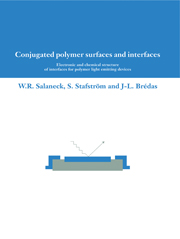 Conjugated Polymer Surfaces and Interfaces
Conjugated Polymer Surfaces and Interfaces Book contents
8 - The nature of organic and molecular solid surfaces and interfaces with metals
Published online by Cambridge University Press: 12 January 2010
Summary
It is perhaps obvious that the nature of the interface between a molecular solid (polymer) and a (clean) metal surface is not necessarily equivalent to the interface formed when a metal is vapor-deposited (essentially ‘atom-by-atom’) on to the (clean) surface of the polymer or molecular solid. Atoms of all metals are active ‘in the form of individual atoms’, even gold atoms. In the context of the new polymer LEDs, some of the works discussed in chapter 7 involve the study of the early stages of formation of the interface in the latter configuration (metal-on-polymer interfaces). Very little has been reported on conjugated polymer-on-metal interfaces, however, primarily because of the difficulties in preparing ‘monolayers’ of polymer materials on well defined metal substrates appropriate for study (via PES or any other surface sensitive spectroscopy). The issues discussed below are based upon information accumulated over two decades of involvement with the surfaces of condensed molecular solids and conjugated polymers in ultra-thin form, represented by the examples in the previous chapter.
Polymer surfaces
It is most straightforward to begin with a brief description of the very nature of the free polymer surface, following which the polymer-on-metal interface is described, before returning to additional facts about the free polymer surface. Some fundamental differences between ideal polymer surfaces and those of conventional inorganic semiconductors are outlined below.
- Type
- Chapter
- Information
- Conjugated Polymer Surfaces and InterfacesElectronic and Chemical Structure of Interfaces for Polymer Light Emitting Devices, pp. 140 - 154Publisher: Cambridge University PressPrint publication year: 1996


